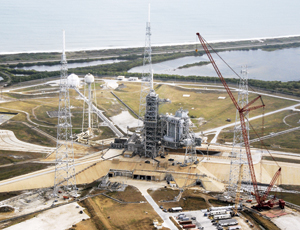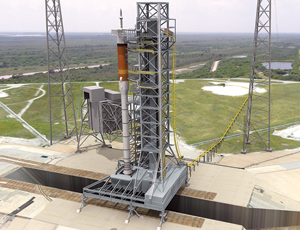For more than 50 years, the National Aeronautics and Space Administration has extended the frontiers of human experience, with audacious landings on the moon, the research of Skylab, the far-seeing eye of Hubble and the reduction of space travel to something so routine a successful space-shuttle launch rates little more than a minute of the evening news. Now, NASA is exploring a frontier it has never encountered before: possible budget shortfalls. When NASA shuts down the shuttle program next year, astronauts wanting to do their part on the International Space Station will have to hitch a ride on a Russian rocket until 2015 because U.S. funding for the space program has remained flat just when the transition to a new space vehicle demands a fresh infusion of cash. The new exploration program has been whipsawed by the opposing forces of 2004’s presidential Vision for Space Exploration to return humans to the moon by 2018 and a world-crippling economic recession that submits such dreams to cost-benefit analysis.
The program, dubbed Constellation, is estimated to cost more than $100 billion over the next 15 years, but that is little more than a guess. Its development is decentralized; design and construction are handled by regional NASA officials at various installations. No single coordinator oversees the far-flung construction programs and construction costs are fluid, dependent on how new systems evolve, officials say.
Constellation aims to develop two new rocket systems, a lunar module called Altair and all the engineering and infrastructure required to make that happen. So far, nearly $7 billion has been spent, with major budget increases scheduled starting in fiscal year 2010. In recent months, with the space shuttle program winding down, design development has flowed into construction, and preparations for Constellation are ramping up at Kennedy Space Center in Cape Canaveral, Fla., and 11 other NASA facilities around the country (see map).
Driven by operating deadlines and its own momentum, NASA is hurtling ahead but toward an uncertain future. The change in administration left the agency without an administrator until May 23, when President Obama tapped former astronaut Charles Bolden Jr. for the job. But Bolden’s marching orders could change: Two weeks before his nomination, Obama named an independent commission to review options for Constellation and other programs, with instructions to make recommendations by August.
The review comes as NASA ramps up Constellation with major infrastructure modifications. Most work involves retrofitting existing facilities with equipment and infrastructure for the new generation of space boosters, Ares I and Ares V. Ares I will enable launching as many as six people into space; the heavy-lift Ares V will launch equipment including the Altair lunar module, and components for building bases on the moon, and later, Mars.
“It’s the biggest facilities program since Apollo,” says Robert Stoljes, exploration systems mission directorate ground-infrastructure manager at NASA headquarters in Washington, D.C. There will be a major transition of facilities from the Space Shuttle Program to the Constellation program over the next several years at NASA sites across the country, he adds.
On May 31, at Kennedy Space Center, NASA transferred Launch Pad 39B from the shuttle program to Constellation, and initial demolition of the shuttle’s fixed structures began. Kennedy’s Launch Complex 39 pads A and B have launched all shuttle missions since the first, in 1981. Before the shuttle, Apollo/Saturn and other early launches were assembled in the towering Vehicle Assembly Building and transported together with their service structures at about 1 mph to the launch pad a couple of miles away on the Mobile Launcher, a 160-ft x 135-ft steel platform 25 ft high and mounted on a 20-ft-high crawler-transporter. The shuttle, in contrast, is assembled in the Vehicle Assembly Building without a service structure. Instead, its 247-ft-tall fixed service structure is permanently mounted on the launch pad, with a rotating service structure that swings into position once the shuttle is delivered to the pad.
The new Ares rocket will be delivered to the pad with a 390-ft-tall tower on the mobile launcher. “The rotating service structure and the fixed service structure will be built on the platform for Ares, allowing the cables, umbilicals and other lines to be connected in the Vehicle Assembly Building, rather than outside,” says Jose Perez Morales, Constellation program’s pad senior project manager. The new system thus requires major changes to the launch pads.
Construction of a new lightning protection system was 90% completed earlier as the first step. To replace a single 80-ft fiberglass mast topping the fixed service structure, Reynolds, Smith & Hills Inc. (RS&H), Jacksonville, Fla., designed a catenary wire system of cables strung between three 594-ft-tall steel towers surrounding the pad. Ivey’s Construction Co., Merritt Island, Fla., began constructing the $28-million system in September 2007 and strung a temporary cable in March this year. The catenary system will be completed after the launch of Ares I-X, an unmanned rocket that will test the Ares design, now scheduled in September.
With Constellation, NASA will return to the launch-and-splashdown approach of the Apollo program. The Orion crew capsule, with a cone shape similar to Apollo’s, will be manufactured in the Operations and Checkout Building at Kennedy by Lockheed Martin Space Systems Co., NASA’s Orion contractor. Hensel Phelps Construction Co.’s Orlando, Fla., office started work in April 2007 on a fast-track, guaranteed-maximum-price contract now worth roughly $40 million to reconfigure the manufacturing space and completed the baseline scope last January, says Scott Shelby, Hensel Phelps project manager. The remaining work in the building will be completed in September, he says.
The project is a 90,000-sq-ft gut and rehabilitation, with design engineering done in-house, says Richard F. Harris, director and Orion deputy program manager for Lockheed Martin. “A lot of old legacy systems—air-conditioning—and hazardous materials are left over from previous programs,” he says, including mercury and asbestos. Production is scheduled to start next year, he adds.
Hensel Phelps now is halfway through constructing the new mobile launcher, designed by RS&H, in a parking lot behind the Vehicle Assembly Building. Construction of the $130-million launcher began in May 2008 and is...






























Post a comment to this article
Report Abusive Comment